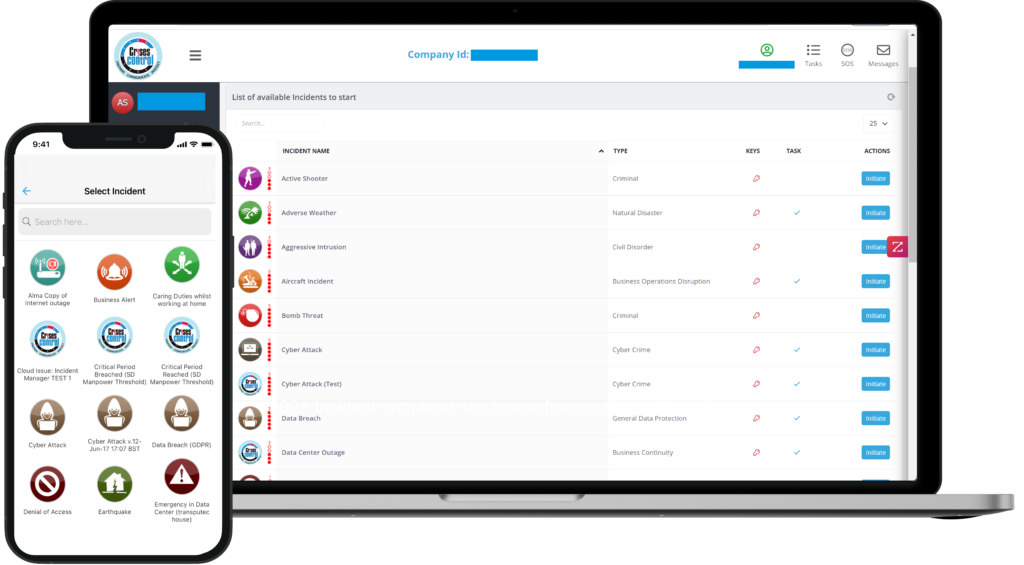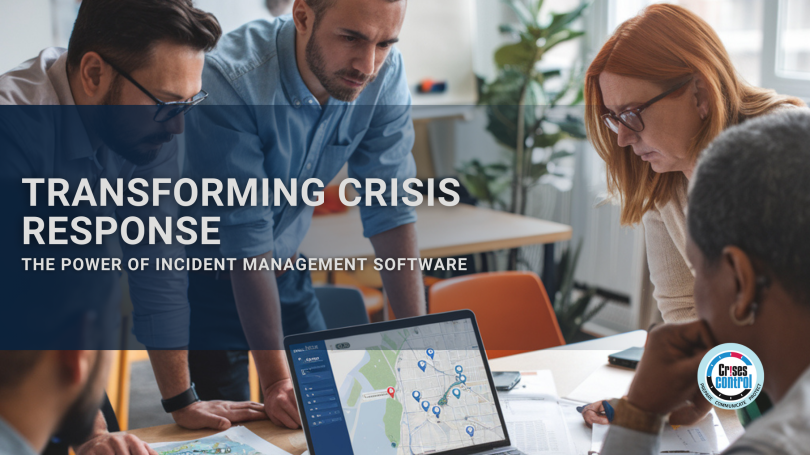Written by Ikram Tassi, Marketing
In today’s fast-paced, unpredictable world, crises can arise at any moment. Whether it’s a security breach, a natural disaster, or an operational failure, your response time can make a significant difference in how swiftly the situation is contained and resolved. Efficient crisis management is more than just reacting – it’s about being prepared, informed, and responsive, even before an incident occurs.
This is where Incident Management Software plays a crucial role. Incident Management Software for crisis response is a comprehensive tool that helps organisations respond quickly and effectively to emergencies. It integrates communication, coordination, and incident logging into a single platform, ensuring that every part of the organisation is aligned and prepared for the unexpected.
In this blog, we’ll delve into the core functionalities of Incident Management Software, discuss why it’s essential for effective crisis response, and highlight how Crises Control’s platform offers the perfect solution for organisations looking to streamline their crisis management processes.
Why Crisis Management Requires Advanced Software
Crises come in many shapes and forms, from physical emergencies such as fires, accidents, or natural disasters, to digital threats like cyberattacks or data breaches. Regardless of the type, the key to minimising the impact of a crisis is a rapid and organised response. The complexity of modern crises demands a strategic approach that manual processes simply cannot deliver.
Traditional methods of managing incidents, such as phone calls, emails, and physical meetings, are often slow and inefficient. In contrast, Incident Management Software provides a centralised platform where every step of the crisis response is automated and coordinated, improving efficiency and decision-making.
At the core of this software is its ability to manage information in real time. During a crisis, it’s not only critical to act quickly but also to have a clear, accurate understanding of the situation. Incident Management Software ensures that all relevant information is gathered, tracked, and distributed in real time, so decision-makers are fully informed and can respond effectively.
Moreover, these systems integrate seamlessly with other crisis management tools, such as Mass Notification Systems, enabling automated alerts and communications. This ensures that all stakeholders—whether employees, partners, or external responders—are immediately aware of the crisis and know what steps to take.
Key Features of Incident Management Software for Crisis Response
1. Real-Time Alerts and Notifications
One of the most important features of incident management software is its ability to send real-time alerts and notifications. When a crisis occurs, rapid communication is critical for minimising its impact. Incident management software automates the distribution of messages across multiple channels—email, SMS, phone calls, or even in-app alerts—ensuring that every individual is immediately informed of the situation.
This feature is integrated with escalation protocols to ensure that the right people are notified at the right time. For example, if a crisis requires the involvement of senior management or external emergency responders, the software can automatically escalate the issue to those individuals, ensuring swift action.
Crises Control’s Mass Notification System is integrated into the platform, allowing for a seamless flow of communication across all levels of the organisation. No matter where employees are located—whether they are in the office, working remotely, or in the field—they receive alerts promptly.
2. Centralised Crisis Management Dashboard
A centralised dashboard is an essential feature of incident management software. It consolidates all relevant information—incident status, updates, communications, and tasks—into a single, easy-to-use interface. This gives crisis managers a comprehensive overview of the situation in real time, enabling them to track the progress of the response and make data-driven decisions quickly.
The dashboard serves as the command centre during a crisis, where you can see everything in one place—from incident logs to assigned tasks and team availability. With this centralised approach, there’s no need to switch between multiple platforms or communication channels, allowing for a more streamlined, efficient response.
Crises Control’s Incident Manager provides just such a dashboard, offering real-time updates on the status of the crisis and the response efforts. It gives managers and decision-makers a clear overview, ensuring that no important detail is overlooked during the response.
3. Seamless Communication Across Teams
Crisis response is a team effort, and effective communication between all parties is crucial. Whether it’s within your internal teams or with external partners, incident management software ensures that everyone involved in the crisis response has access to accurate, up-to-date information.
Incident management software facilitates real-time communication across departments, ensuring that all stakeholders are kept informed and aligned on the next steps. With chat, email, and SMS integrations, the software ensures that no critical message is missed.
Moreover, predefined templates for different crisis scenarios streamline the communication process. These templates enable quick, efficient messaging that can be sent out immediately, reducing response times and the likelihood of communication errors.
Crises Control’s platform offers multiple communication channels, including instant messaging, push notification, email, and voice calls, ensuring seamless collaboration during the most stressful moments of a crisis.
4. Incident Logging and Documentation
In addition to managing the crisis in real time, it’s crucial to document every step of the response. Incident management software automatically logs all actions taken, communications exchanged, and decisions made, creating a detailed record of the crisis response.
This documentation serves several purposes: it provides a full audit trail for compliance and legal purposes, helps with post-crisis analysis to identify strengths and weaknesses in the response, and assists with improving future crisis management strategies.
Crises Control’s incident management platform ensures that everything is logged and stored securely, providing businesses with a complete, accessible record of their response efforts. After the crisis has passed, the data can be analysed to improve processes and prepare for future incidents.

Interested in our Incident Management Software?
Customise your Critical Event Management Software to meet your specific needs with our flexible tools & stay connected and informed during the crisis and incident management process
The Benefits of Using Incident Management Software for Crisis Response
1. Faster Response Times
A quicker response is essential to mitigating the impact of a crisis. With manual systems, there are often delays in relaying information and activating response teams. Incident management software, however, accelerates this process by automating key actions such as alerting teams, notifying key stakeholders, and assigning tasks. This removes bottlenecks and allows for a faster, more coordinated response.
By providing immediate notifications and ensuring real-time coordination, Crises Control’s software enables your organisation to act swiftly and decisively in the face of an emergency.
2. Improved Coordination and Decision-Making
Crises are chaotic, and without proper coordination, the situation can quickly spiral out of control. Incident management software improves coordination by consolidating all communications, updates, and tasks in one place. This centralisation ensures that decision-makers have all the information they need to make informed decisions quickly.
The software also allows for a clear distribution of responsibilities. With incident tracking and task management features, teams can be assigned specific roles and responsibilities, ensuring that the response is organised and efficient.
Crises Control’s platform offers advanced coordination tools that facilitate collaboration across departments, ensuring that everyone is working toward the same objective and no vital steps are missed.
3. Minimising Downtime and Operational Disruptions
Operational disruptions caused by a crisis can be costly. Whether it’s a power outage, IT failure, or workplace emergency, time is money. Incident management software helps minimise downtime by streamlining response processes, allowing businesses to recover quickly and resume normal operations.
Crises Control’s platform ensures that response teams are notified instantly and can assess the situation without delay. It also integrates with business continuity plans, enabling the organisation to implement recovery processes immediately and minimise downtime.
4. Enhanced Business Continuity Planning
Incident management software plays a crucial role in business continuity planning. It ensures that recovery plans are in place and can be activated quickly when needed. By providing a clear structure for response, it enhances an organisation’s ability to weather crises and return to normal operations with minimal disruption.
Crises Control enables businesses to create, test, and refine custom business continuity plans. When a crisis occurs, the software guides response teams through the predefined steps, ensuring a seamless recovery.
How Crises Control Helps Your Organisation Respond to Crises
Crises Control is an advanced incident management platform designed to help organisations respond to emergencies with confidence. Here’s how Crises Control supports businesses during a crisis:
1. Comprehensive Solution
Crises Control offers an all-in-one platform for managing the entire crisis response process. From real-time alerts and notifications to post-crisis analysis and reporting, the software ensures a cohesive, organised response.
2. Scalable and Customisable
Whether you’re a small business or a multinational corporation, Crises Control is scalable to meet your needs. The platform can be customised to address the unique challenges your organisation faces, providing a tailored solution for crisis management.
3. Seamless Integration
Crises Control integrates with existing enterprise systems, including HR, security, and communication tools. This ensures that the software works within your existing infrastructure, making it easier to manage incidents from a single platform.
Conclusion: Ready to Take Control of Your Crisis Response?
Incident management software is essential for organisations that want to respond to crises effectively. With Crises Control, you can ensure that your team is always prepared, communication is seamless, and recovery is quick and efficient.
Get started with Crises Control today and experience firsthand how our platform can transform your crisis response. Contact us to schedule a free demo and see how Incident Management Software can safeguard your organisation during any emergency.
Request a FREE Demo









